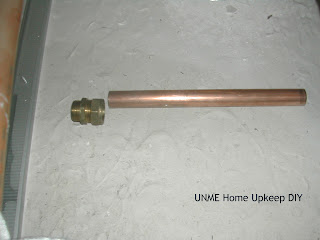
My tranquil lifestyle was disrupted by a telephone call from my wife, with a panicky tone. “The solar water heater is leaking non-stop.” she exclaimed. I asked her to check for the source of leakage and called the solar heater vendor for assistance.

The picture on the right shows the leakage from the water heater intake tank. The picture on the left, with the yellow and red colour tapes, shows the leakage from the two PVC coupling joints.
The solar heater vendor quoted a fee of RM250.00 (USD70.00) just to inspect and identify the source of leakage. Repair charges and material costs will be billed in addition to the inspection fees.
As a DIY buff, I would not pay for the charges without attempting the repair myself. The water was leaking at a rate of about 6 gallons a day. This was tolerable.

The picture on the right shows the PVC coupling joints and the 9-inch PVC pipe removed.
There were two points of leakage. The first one was at the intake tank due to the ball float valve while the second point was the PVC coupling joint inside the ceiling. These can be repaired easily. Just replace the valve and the coupling joint and the leakages can be plugged.

The cost of replacing the complete set of Italian-made ball float valve was RM29.00 (USD7.60) and the copper coupling joints (two pieces) plus the 9-inch length of ¾ inches diameter copper pipe cost RM21.00 (USD5.50).
 The picture below shows the PVC pipe replaced with copper pipe.
The picture below shows the PVC pipe replaced with copper pipe.The vendor would most likely charge RM500.00 (USD131.50) for the entire job. The whole task took about an hour to complete. Therefore, it pays to be a handyman at home.
A professional workman in Malaysia may not be as professional as you think! Can a professional plumber use a PVC coupling joint to connect insulated copper pipes for hot water?
 See the picture below. The pressure plus the hot water at more than 70 degrees Celsius oozed a hole at the PVC joint. So, it is useful to have some technical knowledge of things inside your house. Otherwise, you'll get conned by unscrupulous workmen!
See the picture below. The pressure plus the hot water at more than 70 degrees Celsius oozed a hole at the PVC joint. So, it is useful to have some technical knowledge of things inside your house. Otherwise, you'll get conned by unscrupulous workmen!Visit some of my link sites for more DIY tips.

